Dear Friends,
Thank you for subscribing to our monthly eletter so that we can share with you news of our recent and forthcoming publications, the latest advice from Lama Zopa Rinpoche, new teachings and translations on our website, and a previously-unpublished teaching drawn from our archive of transcripts. We can rejoice in our work together making these precious teachings available in myriad ways for anyone to read, listen to and watch wherever they are.
LHABAB DUCHEN: A Meritorious Holiday
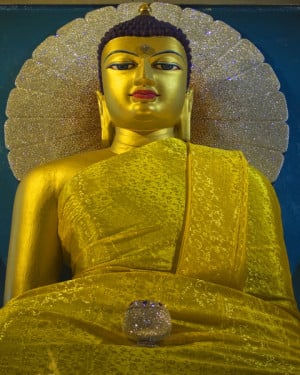 On Tuesday, November 3, we celebrate Lhabab Duchen, which commemorates Lord Buddha's actual descent from the Realm of Thirty-three. Like the other great Buddhist holidays, Lhabab Duchen is a very powerful time to accumulate merit. You can find Lama Zopa Rinpoche's recommended practices for these karmically powerful days on the FPMT website. As cited by Rinpoche from the Vinaya text Treasure of Quotations and Logic, the merit created by actions done on these special days is multiplied by one hundred million.
On Tuesday, November 3, we celebrate Lhabab Duchen, which commemorates Lord Buddha's actual descent from the Realm of Thirty-three. Like the other great Buddhist holidays, Lhabab Duchen is a very powerful time to accumulate merit. You can find Lama Zopa Rinpoche's recommended practices for these karmically powerful days on the FPMT website. As cited by Rinpoche from the Vinaya text Treasure of Quotations and Logic, the merit created by actions done on these special days is multiplied by one hundred million.
So this is a perfect time to make a donation to join in the work of the Archive. Your $100 donation will carry the power of $10 billion!
Please support our work for the coming year and join us in spreading the Dharma to all beings everywhere. Click here to donate and read on to see the kind of precious work that your donations will support!
More Multimedia Titles
 A few months ago we announced the release of our newest multimedia title, Lama Yeshe's The Three Principal Aspects of the Path. The multimedia offerings weave the many resources of the Archive-- transcripts, images, audio and video-- into beautiful Dharma titles that deepen your experience of these precious teachings.
A few months ago we announced the release of our newest multimedia title, Lama Yeshe's The Three Principal Aspects of the Path. The multimedia offerings weave the many resources of the Archive-- transcripts, images, audio and video-- into beautiful Dharma titles that deepen your experience of these precious teachings.
This month, we bring you the re-release of our earliest multimedia offerings, Lama Zopa Rinpoche's The Merely Imputed I and Lama Yeshe's Making the Most of Your Life. These titles have been redesigned using the latest multimedia publishing tool, which allows all of these titles to be accessed through any web browser on your phone, tablet or computer, and the book will be perfectly formatted for each.
We have many more of these multimedia titles in the works. Please check them all out, and we welcome any feedback you have for us at [email protected].
Transcribe, Edit, Publish, Repeat
Each month we post new teachings to our website. This month we have posted a talk titled The Essence of Dharma Practice, given by Lama Zopa Rinpoche to a group of Russian students at Root Institute, Bodhgaya, India in January 2003. In this teaching, Rinpoche discusses correct devotion to the virtuous friend, living our life with the good heart and advice on how to study and meditate on the lamrim, the path to enlightenment. Transcribed and edited by Ven. Ailsa Cameron. An excerpt from this teaching is this month's eletter teaching below.
We are so happy to be able to bring you these newly-published teachings! But do you realize how many hours of work it takes to go from the recorded teaching to the words that you can read on the page? First, a transcriber listens to each recorded teaching very carefully. As they listen, they transcribe Rinpoche’s each and every word verbatim. This transcript is checked against the recording by a second transcriber to assure accuracy. Finally the confirmed transcript is then lightly edited for clarity and your ease of reading.
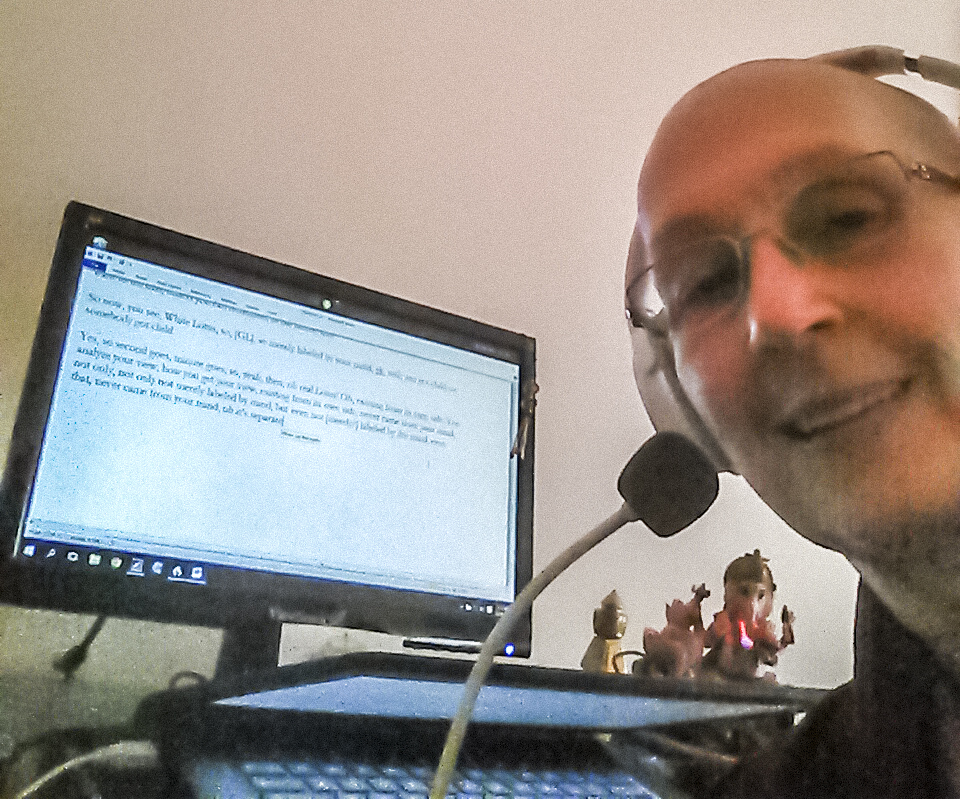
We all have been so fortunate to have LYWA Transcriber Ven Thubten Munsel transcribing Rinpche's precious words for the benefit of all since 2008. Her experience and skills are incredibly precious and irreplaceable. So, when Ven Munsel told us a few months ago that she was experiencing repetitive stress injury in her arms, we were more than a little concerned.
But Ven Munsel, ever the Dharma warrior, learned how to transcribe without typing. With the help of our friends in FPMT International Office, Ven Munsel was set up with Dragon software, so that she can listen to Rinpoche's words and repeat them, and have Dragon type the transcript for her. When we asked her how it compared to typing, she explained: There's always that slight pause, when you listen to Rinpoche, then transcribe. I was, past tense, a fast typist. That being said, I'm taming the Dragon, and it's pretty amazing, the results. I always check to make sure it gets all the words down. Otherwise, pretty close. Check out her selfie, with her new setup. We are all so amazed and grateful for Ven Munsel's skills, tenacity and incredible devotion to Rinpoche in continuing to bring his precious words to us all.
New Advice from Lama Zopa Rinpoche
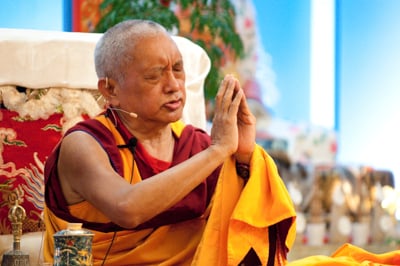 This month we have posted two advices from Rinpoche on karma. The first is an extensive advice on Karma and Its Results where Rinpoche emphasizes the importance of living in pure morality and of understanding the suffering of this life. The second is a letter to a student who felt a deep sense of regret and fear of the harm she had done to other beings in the past and asked Rinpoche about Purifying the Karma of Harming Others.
This month we have posted two advices from Rinpoche on karma. The first is an extensive advice on Karma and Its Results where Rinpoche emphasizes the importance of living in pure morality and of understanding the suffering of this life. The second is a letter to a student who felt a deep sense of regret and fear of the harm she had done to other beings in the past and asked Rinpoche about Purifying the Karma of Harming Others.
There are also two new advices on bodhicitta. The first is a response written to a student who had just completed Lama Zopa Rinpoche’s advice of accumulating 200,000 Vajrasattva mantras and had written Rinpoche to let him know. Rinpoche responded with thanks and teachings on the power of bodhicitta. Also, Rinpoche gave advice on Effortful Bodhicitta Motivation to a student who was planning on entering retreat. Rinpoche closes with:
Doing everything with a bodhicitta motivation is a very wise way of practicing Dharma, a quick way to achieve enlightenment for sentient beings. By practicing in this way as much as possible, not only your meditation but your whole life—even walking, sitting, sleeping, eating, working and so forth—becomes the cause of happiness for all sentient beings and especially enlightenment. That is incredible. It is the most beneficial life. When that happens your life is most beneficial and most meaningful.
Other new advices include advice from Rinpoche on Preliminaries, Arya Sanghata Sutra and Lamrim; a letter about Bodhi Seeds and how they are beneficial for treating various diseases; what practices to do during Solar Eclipses; and advice about practices that may help a person who had contracted Ebola.
As always, you can see the list of all newly-posted advices on our View and Search Online Advice Book page on our website.
New Translations on Our Website
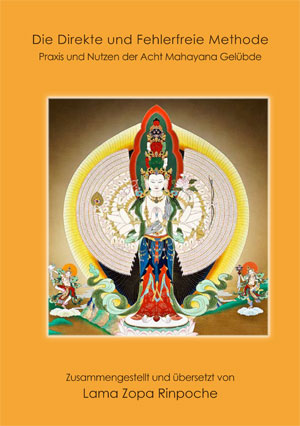 Over the past month our web editor Sandra Smith has been hard at work catching up with posting the many new translations we received over the past few months, while we were putting the finishing touches on the new website. We have so many new translations to share! Most are available to download as pdfs.
Over the past month our web editor Sandra Smith has been hard at work catching up with posting the many new translations we received over the past few months, while we were putting the finishing touches on the new website. We have so many new translations to share! Most are available to download as pdfs.
Our friends at Aryatara Publications have shared with us two new translations into German of two of Lama Zopa Rinpoche's books: The Direct and Unmistaken Method and Daily Purification: A Short Vajrasattva Practice. Note that this version of Daily Purification also includes a commentary on the practice by Dagri Rinpoche. See our German Translations page for links to these and other German translations of LYWA publications.
We also have 2 new Russian translations to share with you. We recently received a beautifully designed version of Lama Zopa Rinpoche's The Heart of the Path, translated by Maya Malygina and edited by Yury Kanchukov. This book is freely available to read and download from our Russian Translations page.
You can also find a pdf of Lama Yeshe's The Peaceful Stillness of the Silent Mind, translated by Anastasiya Makarova and checked and compiled by Ana Stoliarova. Thanks to the hard work of these translators, we have more Russian translations on the way! Next up: Lama Yeshe's Ego, Attachment and Liberation and Universal Love. See our Russian translations page for these and other Russian translations of LYWA publications.
We have also posted two new Vietnamese translations of talks by Lama Yeshe, On Marriage and Be Your Own Therapist. You can find these on the Vietnamese Translations page on our website.
And, last but certainly not least, we received a Croatian translation of a short Tara practice composed by Lama Zopa Rinpoche which had been posted on our website. You can find a link to it in the Related Links section on the right of the Tara Practice page.
We rejoice in the work of all those who translate these precious teachings so that they are even more accessible to students than they were before.
News From the Home Office
 Last month our Epublishing and Social Media Marketing Manager Megan Evart visited the home office in Lincoln Massachusetts for a series of meetings with IT and Finance Manager Jen Barlow. During the meetings we discussed our plans for managing our ever growing collection of audio, video, images and transcripts so that we can more quickly make them available to everyone in all ways possible. We discussed the emerging technologies for improving our systems for storing, cataloging and accessing the LYWA collection and, together with LYWA's Digital Imaging Specialist David Zinn, began evaluating digital asset management systems to coordinate, streamline and improve the publishing process for our entire digital collection.
Last month our Epublishing and Social Media Marketing Manager Megan Evart visited the home office in Lincoln Massachusetts for a series of meetings with IT and Finance Manager Jen Barlow. During the meetings we discussed our plans for managing our ever growing collection of audio, video, images and transcripts so that we can more quickly make them available to everyone in all ways possible. We discussed the emerging technologies for improving our systems for storing, cataloging and accessing the LYWA collection and, together with LYWA's Digital Imaging Specialist David Zinn, began evaluating digital asset management systems to coordinate, streamline and improve the publishing process for our entire digital collection.
We are excited about the projects coming up for us over the next few years and will share with you news about them as they unfold. Of course, we made time to take a break and visit Walden Pond to enjoy a late-summer afternoon walk.
Thank you all for your incredible support, and for joining us in this amazing work.
Much love,
Nick Ribush, Director
This Month's Teaching: How to Practice Dharma in Daily Life
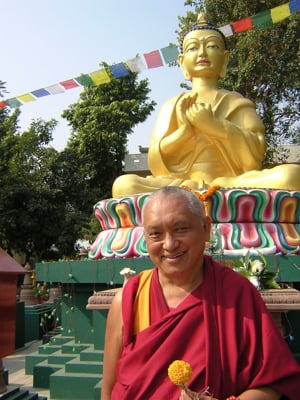 In regard to how to practice Dharma in daily life, first you should study at least one lamrim text, such as Lama Tsongkhapa’s lamrim commentary, from beginning to end. After you have studied the text, if possible, read over it two or three times. Generally, it’s good to read such texts many times, because each time you read the text, you understand something more, even though you have read it before.
In regard to how to practice Dharma in daily life, first you should study at least one lamrim text, such as Lama Tsongkhapa’s lamrim commentary, from beginning to end. After you have studied the text, if possible, read over it two or three times. Generally, it’s good to read such texts many times, because each time you read the text, you understand something more, even though you have read it before.
Then every day do a little meditation on guru yoga, by either following the lamrim outlines or doing something short as I have just done, to transform your mind from the ordinary mind that sees mistakes into the pure mind of devotion that sees the guru as a buddha. Do a little guru devotion meditation every day until you have stable realization. Even after you have the realization, you still need to continue the meditation a little to stabilize the realization so that you don’t lose it.
You can make a general plan of meditation in the following way. Your project of meditation for the first year is to work mainly on the graduated path of the lower capable being in general. You can spend one year on that, meditating step by step from perfect human rebirth up to karma. In order to have realization, you meditate every day for one year on the lower path. The next year you meditate mainly on the path of the middle capable being, basically to develop some feeling of renunciation. The following year you can meditate mainly on bodhicitta. And the next year you can spend your time meditating mainly on emptiness. However, you could also meditate on emptiness every day.
This is one way to meditate on the lamrim in order to achieve realization of the three principles of the path. It doesn’t mean that you can’t meditate on bodhicitta while you are meditating on the lower path, but your main focus during that first year could be the lower path. The main thing is that after you achieve realization of the lower path, you need to put time and effort into achieving realization of the renunciation of the whole of samsara. First you develop renunciation toward this life, then second, renunciation toward the whole of samsara. To develop the first level of renunciation, you meditate on the lower path, especially on impermanence and death, the sufferings of the lower realms and karma. Your heart will then totally change.
At the moment the happiness of this life is more important and the happiness of future lives is secondary. After you do these meditations, there will be a total change in your heart. Achieving the happiness of future lives will become the most important thing and whether or not you achieve the happiness of this life will become unimportant. You will see work for the happiness of this life as totally meaningless. In your heart achieving the happiness of future lives will become the most important thing. Your attitude will totally change. So, until you have stable realization of renunciation of this life, you meditate on the lower path. This means until you have the realization that sees the whole of samsara—including the human realm and even the deva realms—only in the nature of suffering, like being in the center of a fire. You have the realization of renunciation of samsara when you are like a prisoner who feels it is so unbearable to be in prison that the thought to get out arises day and night without effort.
Once you have that realization, you then put your main effort into the graduated path of the higher capable being, into generating bodhicitta. When you achieve one realization, you then put your effort into the next meditation. I mentioned before spending one year on the lower path, then one year on the middle path, then one year on bodhicitta, but although you can do that, the time is not the main point. The main point is that when you achieve the realization, you then go to the next level of meditation.
Also, in your daily life, you should do lamrim meditation on the basis of a guru yoga practice, whether Lama Tsongkhapa Guru Yoga, Guru Puja or another guru yoga practice.
You also need to do the practices of purification and of collecting merit. For example, you can do the practice of purification by doing prostrations with recitation of the names of the Thirty-five Buddhas in the morning and in the evening you can do Vajrasattva practice, either with prostrations or in sitting meditation. And the most powerful purification and collection of the most extensive merit come through guru devotion, through following the guru’s advice and offering service to the guru.
In the break-times, when you are not doing sitting meditation but are just living your life, try to live with a continuation of the feeling you generated during your session of lamrim meditation. For example, if you are meditating on impermanence and death during your morning session, continue that thought in your break-times. Because this won’t allow anger, attachment and other delusions to arise, your actions in the break-times will naturally become virtuous. Eating, walking, doing your job—whatever you do will naturally become virtue, or Dharma. In the same way, if your morning meditation is guru devotion, you should continue that guru devotion in your break-times; again, everything you do with that thought will become Dharma. And it is the same with bodhicitta, the good heart. That is how to integrate lamrim with your break-times.
If you have already studied a lamrim commentary, such as Liberation in the Palm of Your Hand, you can follow that meditation outline. Memorizing the outline and meditating on it is one way to meditate on lamrim in your daily life. Once you have studied a lamrim commentary, you can use a short lamrim text, such as The Essential Nectar, as the basis for your lamrim meditation in daily life. The Essential Nectar, which has a commentary by one of my teachers, Geshe Rabten, is one book that I suggest you use for daily meditation on lamrim. It goes straight through the outlines, without many stories or much commentary.
Those who are highly intelligent can use Lama Tsongkhapa’s Lamrim Chenmo, memorizing the outlines and meditating on them. This is what meditators do: they memorize the lamrim outlines in Lamrim Chenmo, Liberation in the Palm of Your Hand or one of the short lamrims, then meditate on the outlines.
In daily life everything you do—eating, walking, sitting, sleeping—should become an antidote to the ego, the self-cherishing thought. Instead of allowing the things you do to become work for the self-cherishing thought, try to make them antidotes to self-cherishing thought. That means doing your daily activities with bodhicitta, with the thought of benefiting others, of cherishing others. When you do activities with that thought, everything you do becomes an antidote to self-cherishing thought; it then becomes the best Dharma, the purest Dharma.
Excerpted from the teaching The Essence of Dharma Practice, a talk given by Lama Zopa Rinpoche at Root Institute, Bodhgaya, India in January 2003. You can read the entire talk on our website.































